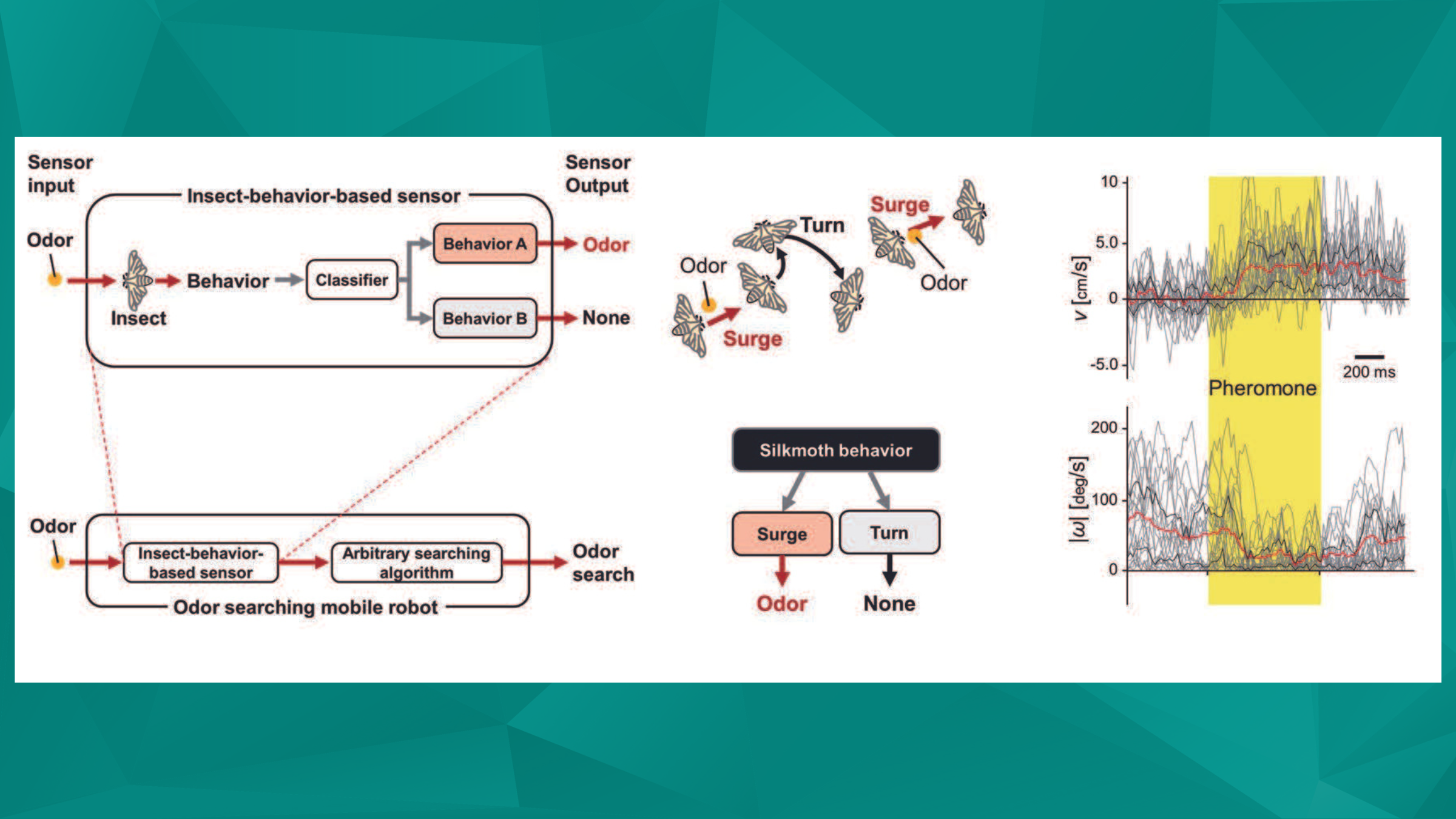
The natural world often serves as inspiration for innovation, and insects – specifically their olfactory systems – have become an expanding research topic of interest. Given the remarkable sensitivity of insect odor detection systems, the potential applications of this budding field are numerous. In this publication review we discuss several new and exciting findings in the olfactory sciences, highlighting how our instruments helped these researchers stir up the lab.
Featured image (©Horibe et al. (2021), licensed under CC BY 4.0), illustrates insect-behavior-based olfactory sensor and odor searching behavior of a silkmoth.
Odor-Searching Robots: Silkmoths Show the Way
Aside from producing their commercially valuable self-named fibers, silkmoths can detect extremely low concentrations of pheromones across vast distances to find a mate. As these insects travel in straight lines when an odor is detected, and in sporadic zigzag lines when no odor stimulus is present, their use as a driver of an insect-behavior-based odor-searching robot could prove feasible, and is what Horibe et al. (2021) sought to address.
Using a spherical treadmill to simulate real-world conditions, as well as our 200B miniPID to measure real-time changes in odor concentrations, a four-wheeled, silkmoth-directed robot was created – capable of locating an odor source with reasonable precision. The varying precision was, in part, due to a high false positive rate caused by rapid movement following odor detection, an intrinsic behavior that likely serves to propel the silkmoths further toward their target scent.
Additionally, while the silkmoths being analyzed only responded to bombykol, the female sex hormone, transgenic silkmoths that express other types of olfactory receptors on pheromone receptor cells have been developed. These insect-behavior-based odor-searching robots could enable scent-based search and rescue operations, extensive ecological monitoring, as well as a vast number of other biorobotic applications.
Locusts as Bio-Sensors for Explosives
While silkmoths can be beneficial for long-range searching, insect-based odor sensing can also be applied to a far more urgent issue. The need for detecting explosives quickly and accurately has led researchers to look beyond traditional electronic sensors and towards effective biological systems, such as locusts. The American locust (Schistocerca americana) is of particular interest for this task, as their olfactory systems are well characterized, they can be conditioned to identify particular odorants, and have a unique neural physiology that allows for easier monitoring of neuronal activity.
Using a series of electrodes placed on the antennal lobe, as well as our 200B miniPID to measure odor gradient within the test chamber, Saha et al. (2020) created a precisely controlled stimulus delivery system that identified the neurological responses of locusts to chemical compounds found in explosives. The study showed that locusts could differentiate between explosive and non-explosive chemicals within milliseconds, and could also differentiate between individual kinds of explosives. This was observed by monitoring projection neurons activated in response to TNT and other commonly used explosives. The applications of this research are considerable, offering a faster, more reliable biological sensor that could be vital for national security measures or a broad variety of other applications.
Detecting and differentiating different cancers
In addition to explosive detection, the olfactory system of locusts are capable of selective discrimination of other odorants – something that may be of particular benefit in oncology. For example, no validated screening tests for head and neck cancers are currently available. Given the overwhelming evidence supporting the release of volatile organic compounds (VOCs) as cancer cells switch from glycolysis to oxidative phosphorylation, detection of cancers through biological sensors holds great potential for cancer diagnostics.
Through the integration of a live insect brain monitored through electrophysiological recordings, as well as precise VOC delivery with Aurora 220A Olfactometer to calibrate the sensor, a precise and reliable tool was then created by Farnum et al. (2022). This system is capable of rapidly distinguishing between different kinds of cancers, with cancer detection occurring within 250 ms of odor onset. The locusts could also differentiate between oral cancer and non-cancer at different stages of growth, highlighting the potential of these insects as biological sensors.
Conclusions
The emerging discoveries in the field of olfactory sciences are nothing short of transformative, offering a range of applications that span from biorobotics to national security and healthcare. Insects such as silkmoths and locusts are proving to be invaluable models for advancements in odor detection systems. These breakthroughs have been enabled, in part, by precise and reliable instrumentation, underlining our company’s ongoing commitment to scientific innovation. As additional findings emerge demonstrating the wide variety of applications for insects, it is clear that the natural world will continue to serve as inspiration for innovation, hopefully well into the future.



